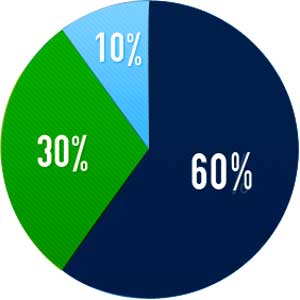 What is your social media content strategy? Do you even have a social media strategy for your business or do you just share your blog posts and some random status updates? It doesn’t matter if you do or don’t. In either scenario, you’re clearly interested in both or you wouldn’t be here reading this labour of love.
What is your social media content strategy? Do you even have a social media strategy for your business or do you just share your blog posts and some random status updates? It doesn’t matter if you do or don’t. In either scenario, you’re clearly interested in both or you wouldn’t be here reading this labour of love.
Your social media strategy is nothing but a blueprint for how you approach your online audience on social media platforms. We’ve already written about social media blueprint. We’ve even dealt with the different types of social media content. In fact, we’ve tried to cover as many aspects of social media marketing as we can. Still, we’re aware that there are still gaps. Luckily, our readers tell us what they want to know more about. One of our readers wanted us to talk about social media content ratio. So, here we are addressing that query.
What Is Social Media Content Ratio?
 The term social media content ratio refers to the relationship between the types of content you share via your business accounts. The primary purpose of social media content ratio is to ensure consistency for a particular account. For instance, if you knew the order in which you share specific types of content, you’ll be able to plan in advance with respect to the creation of those pieces of content.
The term social media content ratio refers to the relationship between the types of content you share via your business accounts. The primary purpose of social media content ratio is to ensure consistency for a particular account. For instance, if you knew the order in which you share specific types of content, you’ll be able to plan in advance with respect to the creation of those pieces of content.
Another benefit of deciding upon a specific social media content ratio is that it makes monitoring the social media campaign easier. Furthermore, analysis of all gathered statistics also becomes easier with the sharing pattern set in advance. For example, if a particular period in a day, week, or month is yielding better engagement, you can pinpoint the type of content doing it. Subsequently, you move the scheduling of that type of content to other days and see if the effect follows it. This way, you can find out if it is the content or the time period that is proving to be effective.
There are various social media content ratios you can choose to start your social media campaign with. As a matter of fact, internet gurus the world over have come up with most of these ratios. Here are some examples.
The 4-1-1
 This social media content ratio takes into account the relationship between three primary objectives of social media marketing. These are education, connection, and promotion. If you were to follow this ratio, you would be posting four pieces of original content, sharing one piece of content from someone else in your industry, and pushing one piece of promotional content.
This social media content ratio takes into account the relationship between three primary objectives of social media marketing. These are education, connection, and promotion. If you were to follow this ratio, you would be posting four pieces of original content, sharing one piece of content from someone else in your industry, and pushing one piece of promotional content.
This ratio makes sense for two reasons. The first is that your focus will remain the followers, customers, and clients and the other is that there is a balance between self-promotion and making connections within the industry. Another benefit of this ratio is that it will help you side-step marketing fatigue neatly.
The 5-3-2
 This ratio focuses completely on the source of your content. It doesn’t concern itself with the nature of your content or even its type. It relies on the source of your content to govern its intention and type both.
This ratio focuses completely on the source of your content. It doesn’t concern itself with the nature of your content or even its type. It relies on the source of your content to govern its intention and type both.
In fact, even the nature of what you share can be said to be a result of its source. For instance, unless you put some real effort and a boatful of resources into it, content you create will always follow a certain theme or style. On the other hand, content you pick up from various sources will inherently be diverse.
This is exactly what this social media content ratio banks on. In this ratio, the maximum number of content you share (5) will be from others. This will automatically ensure variety and prevent monotony in your content. This will also make your account more neutral and less self-serving in the eyes of your existing as well as your potential followers.
However, unless you can push your agenda, a social media profile has no use. This is why this ratio allows you to share three pieces of your own content for every five you share of others. In order to make your account less formal and corporate, this ratio even calls for a couple of personal status updates.
The 5-5-5+
 This ratio is probably the simplest in this list. This ratio calls for parity between different types of content. It asks for five pieces of content created by you or your business, five from other sources, and five responses or replies to what you’ve already shared. This ratio will also make it easier for your business to schedule your postings because you can split things three ways.
This ratio is probably the simplest in this list. This ratio calls for parity between different types of content. It asks for five pieces of content created by you or your business, five from other sources, and five responses or replies to what you’ve already shared. This ratio will also make it easier for your business to schedule your postings because you can split things three ways.
The plus sign in this ratio, however, is the wild card. It is also important because it has the potential to bring in that ‘x’ factor. This is also where you can be experimental and creative with what you share. The + here is basically anything of interest to your followers. It could be a new Hashtag that you’re trying to introduce or even some form of user-generated content that you’re trying to encourage.
The 30-60-10
 The biggest risk for any business on social media is the hard sell. Virtually, every business starts with the objective of directly boosting sales.
The biggest risk for any business on social media is the hard sell. Virtually, every business starts with the objective of directly boosting sales.
This means they’re looking for click-through traffic onto their product pages that converts into a sale. Social media, I’m afraid just doesn’t work like that.
This is why most social media content ratios tend to limit promotional content of all types into a minimalistic percentage of the entire content strategy.
In this social media content ratio, the 10 percent is dedicated to all types of promotional content. This includes everything from the softest of persuasion to the hardest of sells. Like all other ratios, this one also relies on curation because it promotes coordination with other players in the market and ensures visible neutrality. While the 60 percent is for curation, 30 percent is set aside for your own content.
This means that if you’re aiming for 10 posts per week, you need six from other players and three from your own mill along with a single promotional one.
The 4-1
 Each social media content ratio mentioned till now tries to talk about content from the perspective of where it originates from. There’s another angle from which you can view it. This is the angle of the type of content. There are various types of social media content out there. We even have a post explaining the various types of social media content.
Each social media content ratio mentioned till now tries to talk about content from the perspective of where it originates from. There’s another angle from which you can view it. This is the angle of the type of content. There are various types of social media content out there. We even have a post explaining the various types of social media content.
This ratio, however, doesn’t categorise content like we did. It talks about the extremely basic categorisation i.e. links, text, images, quotes, polls, etc. It still makes sense, of course. This ratio asks you to pick any one type of content to be your primary type of content. For most of you, it should be blog posts i.e. links because that is the easiest and simplest to create for small to medium scale businesses.
Once you’ve chosen your primary type of content, this ratio asks you to share one other type of content for every four primary type you share. The objective of this social media content ratio is simple – make sure you have variety in what you do online.
THANK YOU!!!!!!!!!!!!!!!!!!!!!